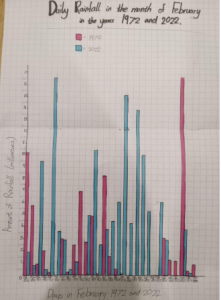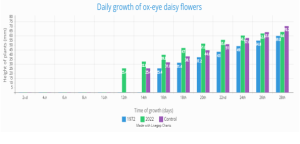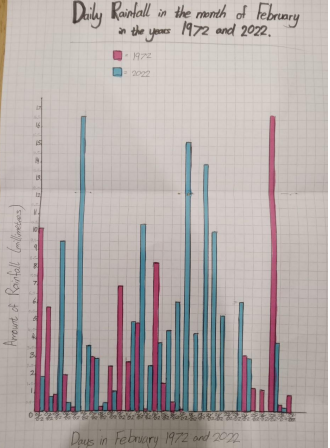Climate Detectives Projects 2022-2023
Project title: The effect of rainfall on native vegetation
Team: Rain For Gain
Clonaslee College Clonaslee Ireland 4 Student’s age: 16-17 years old
Does rainfall increasing as a product of climate change affect the growth of vegetation negatively?
We started our project by collecting rainfall in January so we could use it to water the wildflowers
so that we would not affect the results by using tap water that would contain chemicals that
natural rainwater would not contain. We began gathering our data by planting ox-eye daisy seeds
in three separate plant pots on February 1st, that were labelled 1972, 2022 and Control. We
watered the seeds using the rainwater we had collected in January. We gave the seed that was
labelled 1972 2.534 mm of water every day, which was the average daily rainfall for the month of
February in 1972. We watered the seed labelled 2022 4.711 mm of rainwater every day, as this
was the daily average of rainfall for the month of February in 2022. We watered the control seed
3.629 mm, which we found was the correct amount of water a plant should be given every day
according to https://www.bobvila.com/articles/watering-plants/. We watered the ox-eye daisies
the same amount of water each day and we counted the days until the flowers germinated. Then
once they had germinated, we also measured their growth every day for the month of February by
measuring the stem of the flowers with a ruler. The independent variable in our investigation was
the amount of water each flower received every day, the dependent variable was the growth of
the flowers and the time they took to grow, and the controlled variables were the sunlight the
flowers received and the soil they were planted in.
Our hypothesis is that due to the recent increase of rainfall, that is being caused by climate change,
the growth of vegetation is being affected negatively.
We will investigate the possibility that if vegetation is not given the chance to grow it will affect the
wildlife of the area.

From our investigation we learned that the increasing levels of rainfall have a negative impact on
the growth of local wildlife. Watering the flowers with different levels of rainfall each day, we have
discovered that the rainfall in 2022 affects the growth of the ox-eye daisies. The ox-eye daisies that
received the average rainfall from 2022 germinated the earliest and grew the fastest but after
three days of growing the growth of the daisies began to slow down.
Climate change is increasing the levels of rainfall. We can see this when we compare the
rainfall from 1972 to 2022. In February 1972, the average daily rainfall was 2.524 mm and
in February 2022, the average daily rainfall was 4.711 mm.
– We found that the ox-eye daisy we watered with increased daily rainfall from 2022,
germinated the quickest and had a head start at growing. However, the flower’s quick
growth did not continue. It began to slow down, and the control flower passed it out in
size. The flower’s reduction in growth may have been caused by nutrients being leached
from the soil by the excess water or by bacteria that had begun to grow in the roots
causing them to rot.

– If we did the investigation again, we would examine the root structure for decomposition
to see if that was the problem.
– If the plant germinates early, as the 2022 rainfall specimen and initially grows too quick
also may mean it doesn’t get a chance to produce enough cellulose and lignin, meaning the
stems are too weak to support the plant and sustain growth.
– Yes, we have answered our research question by discovering that the increase in rainfall in
recent years does affect the growth of plants negatively. However, if we studied the
flowers for longer, we could have found a more definitive answer and found if the 2022
flower would continue to slow in growth compared to the rest.
– If we did the investigation again, we would also use several types of native vegetation to
investigate the effects of increased rainfall on a wider sample and not just one type of
flower.
– Our solution Use conservation tillage or raised beds when planting and growing plants
from seeds. Conservation tillage involves limiting the disturbance to the soil. This improves
soil aggregate stability, it also reduces soil erosion, improving soil fertility and water
infiltration. Raised beds are more productive than ground beds because the soil is less
compacted, allowing water to flow more easily through the soil resulting in better
drainage. Adding worms to the soil will also improve natural drainage
– Increasing levels of rainfall caused by climate change is linked to the melting ice caps in
the artic. Since the 1900’s glaciers around the world have been rapidly melting. Human
activities, burning fossil fuels, release CO2 and greenhouse gas emissions which are
causing the Earth to warm up. The raised temperatures cause the glaciers to melt,
resulting in rising sea levels which is increasing precipitation.
Projects are created by the teams and they take the full responsibility of the shared data.
← All projects




